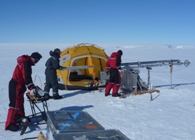Glaciologists head to Antarctica to study large lakes

Professor Bryn Hubbard was a member of the Belissima project that drilled in Antarctica in 2010
22 October 2014
Glaciologists from Aberystwyth University will be flying out to Antarctica at the beginning of November to study the phenomenon of large lakes that have been forming on the surface of ice shelves.
Professor Bryn Hubbard and Dr David Ashmore from the Department of Geography and Earth Sciences’ Centre for Glaciology will be working with collaborators from Swansea University on the Larsen C ice shelf.
Covering and area two and half times the size of Wales, Larsen C is a long, fringing ice shelf in the northwest part of the Weddell Sea, extending along the east coast of the Antarctic Peninsula.
Professor Hubbard and Dr Ashmore will be using hot water to drill up to 150m down into the 200m deep ice shelf to study the many layers of ice that make up Larsen C.
Larsen C is significant for scientists trying to understand the effects of climate change on Antarctica.
Two other ice shelves in the area, Larsen A and B, have broken up and disappeared since 1995 and scientists have been trying to understand what leads to this.
The Aberystwyth team is interested in the phenomenon of large lakes that have been forming on the surface of the ice during warmer weather, usually in January and February.
Almost all Antarctic ice forms over some decades as it is compressed by fresh overlying snowfall, a process called firnification.
However, water in these surface lakes freezes within one winter season, substantially altering the internal density and temperature of ice shelves.
By drilling into the ice shelf, the team hopes to be able to identify the extent of ice shelf alteration by surface lake formation and whether these lakes are a recent phenomenon.
Most of the research into the Larsen shelves to date has been done using satellites and extends only as far back as the early 1980s.
Drilling into the ice should provide the Aberystwyth team with data extending back over 150 years, into the mid-19th century.
Professor Hubbard and Dr Ashmore will be working on the ice shelf until just a few days before Christmas.
During this time they will drill at three locations, 60km apart. The will install measuring instruments which will be left on site for a year and collected in November 2015, when they return to Larsen C.
Speaking ahead of the expedition, Professor Hubbard said; “Despite its accessibility, this region of Antarctica is surprisingly poorly known on the ground. Dark patches on satellite images appear each summer and these are interpreted as large surface melt ponds, but no one has actually studied them on the ground; to date we don’t even have a photograph of the lakes we believe we will see on Larsen C.
“The data we get from this work should contribute to our understanding of how the climate is changing, when these lakes first appeared and their influence, if any, on the breakup of these ice shelves.”
Drilling
The hot water drill used by the team is rugged and mobile, and looks like a pressure washer with a specially adapted nozzle.
Each bore hole will measure 14 cm in diameter and extend up to 150m into the ice shelf.
Drilling sessions are expected to take up to 2 hours with the hot water provided from melting ice.
Approximately 4 tonnes of snow will be required to provide sufficient hot water for each drilling session, all shovelled by hand into a heating tank.
Once opened, the team will insert a camera into the bore hole to study the various ice layers, and temperature gauges that will be left in situ for 12 months.
Funding
The study into the impact of melt on ice shelf stability and dynamics has been supported by C3W (Climate Change Consortium for Wales) and is funded by NERC, the Natural Environment Research Council.
Led by Professors Adrian Luckman from Swansea University and Bryn Hubbard at Aberystwyth University, the mission has been awarded funding of £900,000, with £300,000 allocated to the work of the Aberystwyth team.
AU41814



